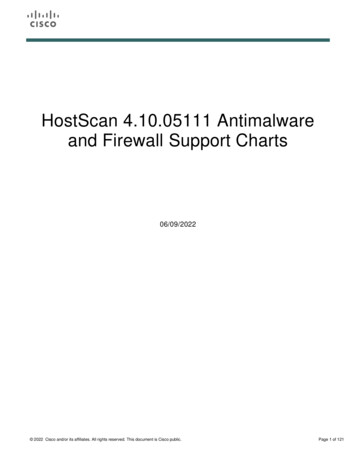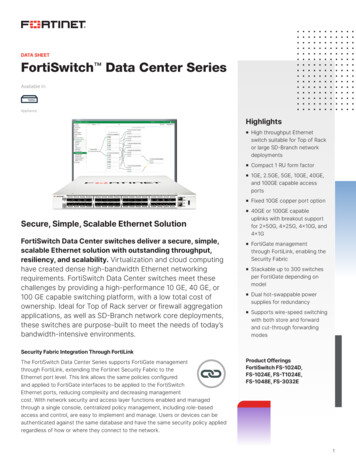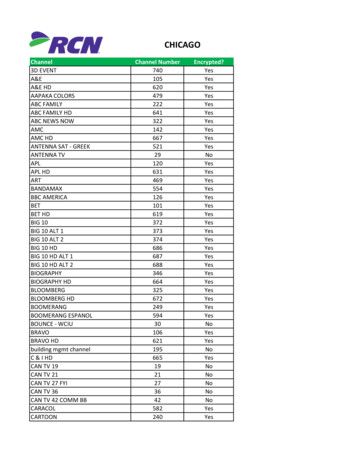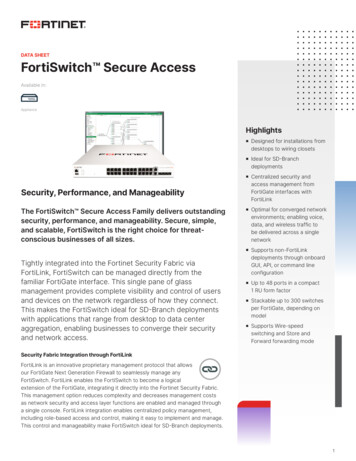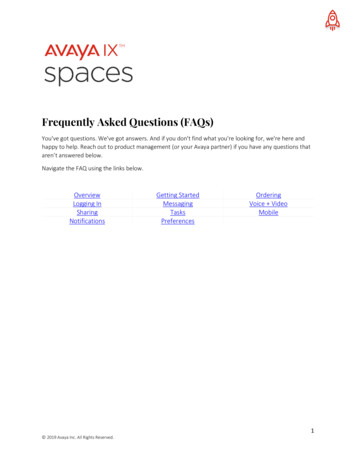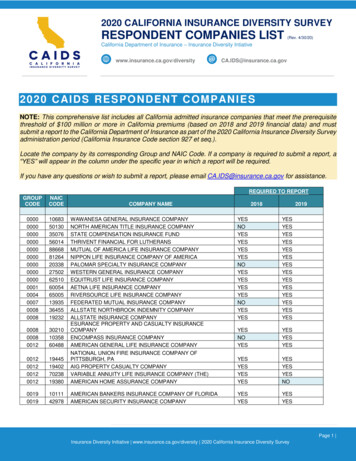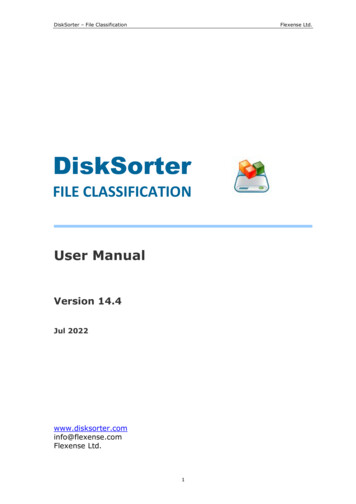
Transcription
Yes, You DO Need Visual IVRFrequently Asked Questions All rights reserved. No part of this document may be reproduced, distributed, or transmitted in any form or by any means, including photocopying,recording, or other electronic or mechanical methods, without the prior written permission of CallVU, except in the case of brief quotations embodiedin critical reviews and certain other noncommercial uses permitted by copyright law. For permission requests, write to CallVU, addressed “Attention:Permissions Coordinator,” at the email address below. marketing@callvu.com www.callvu.com
Yes, You DO Need Visual IVRContentsMigration to Digital Self-Service.3The Art of Gently Moving Customers to Digital Self-Service .3“But Wait!” What We’re Hearing .3We already have IVR, why do we need Visual IVR?4.Will customers activate the Visual IVR session? .5Do we need to create (or recreate) a dedicated app? .6Don’t people call the contact center because they want to speak with an agent? .7We provide self-service via our website, isn’t it enough?8.My IVR self-service statistics are good, why do I need VIVR? .9What about customer privacy and data security?.9.10Does the platform support digital forms?How long is the implementation phase and how quickly can we expect ROI? .11About CallVU .11For more information: info@callvu.com www.callvu.com2
Yes, You DO Need Visual IVRMigration to DigitalSelf-ServiceAcross industries and across the globe, serviceorganizations are encouraging migration todigital self-service. The benefits are clear: lowercosts versus human interactions, elimination ofservice wait time, a richer digital customer journey,enhanced customer satisfaction and brand equity.But now, organizations are ready to see ROI on theirinvestments in digital customer service.Yet despite the strenuous efforts of service centersover the past years, voice calls remain a highly popularform of customer service communication. Inboundcustomer care calls dominate service organizations,and customer service level expectations continueto grow. The cost of meeting these expectationswith a live operator remains high, and customerscontinue to endure the complex, time-consumingexperience of calling the call center. Many, it turnsout, are still not even aware of the advantages ofdigital self-service.Need proof? Recent research found that 63% ofcustomer service calls to banks surveyed weremade for simple requests, notably checkingaccount balance. Ironically, 70% of these servicecalls began with the customer looking up thephone number online. Another study foundthat over 40% of customers in service calls areactually in front of an active web-connectedscreen during the call, or have ready access to aweb-enabled device.The Art of Gently Moving Customers toDigital Self-ServiceTo bring users into online self-service, serviceorganizations need to adopt the right tools. VisualIVR (VIVR) was designed from the ground up to easecustomers into the habit of digital self-service. Withadvanced VIVR solutions like those from CallVU,customers learn that they, too, can enjoy simple,intuitive, and completely digital resolution of issues.VIVR starts as an “on screen phone call” displayinga visual interface that extends from the traditionalIVR menu into an interactive digital journeycomplementing every stage of the customer call.When more complex issues make person-to-personinteraction unavoidable, VIVR offers agents a varietyof tools to collaboratively complete complexprocesses such as filling out forms and signing themin real-time, uploading images, and more.“But Wait!” What We’re HearingThere are numerous and compelling reasons toimplement an VIVR solution. There are also reasons –some quite valid - that service organizations choosenot to implement VIVR. Below, we‘ve collected anumber of the most common questions we hearfrom our future clients, and our thoughts aboutthem.So, if most call center customers have ready Internetaccess, what’s keeping them from choosing digitalself-service? More importantly, what active stepscan service organizations take to encourageadoption of digital self-service?For more information: info@callvu.com www.callvu.com3
Yes, You DO Need Visual IVRalreadyQ. WeVisual IVR?have IVR, why do we needplays a crucial role in the service continuum. What itA. IVRdoes not do, however, is effectively encourage customersto choose digital self-service.VIVR is implemented on top of your existing IVR system,and leverages the existing service scripts and backendintegrations you worked so hard to develop. VIVR doesnot replace IVR. IVR is still required to make the initialconnection for incoming phone calls, and to drive thehybrid voice-and-digital service call flow. IVR will alsocontinue to serve customers calling landlines and forcustomers who are “tech-reluctant”.What VIVR does do is simply provide a better interfaceand better success rates than IVR. Companies who useVIVR report higher scores in service KPIs including: highernumber of transactions, higher task completion rates(TCR), fewer calls flowing to agents, fewer hang-ups inmid-process and even higher customer satisfaction rates.Typical success numbers reported by CallVUcustomers include:Success FactorTraditional IVR Visual IVRInformation processes40%75%Service transactions20%-30%45% -70%Sales transactions3%-7% .30%-40%FAQs Knowledge baseInteractive FormsOnline PaymentsFeedback & SurveysRich Media ContentAccount QueriesFigure 1: CallVU’s Visual IVR PlatformFor more information: info@callvu.com www.callvu.com4
Yes, You DO Need Visual IVRcustomers activate the Visual IVRQ. Willsession?experience shows that they will. CallVU VIVR isA. Yes,activated in two ways:If the user has pre-installed the service provider’s app(i.e. banking, insurance, etc.), the VIVR menu screenpops up automatically when a service phone call isdialed. This is made possible via an SDK embeddedwithin the service provider’s app. Thus, the userdoesn’t need to install any additional software on heror his device.How does this work exactly? Once a call is made,the caller begins to interact with the traditional IVR.However, when the user lowers his or her device topress a number selection as part of the IVR process,the VIVR menu appears on the screen in additionto the number pad. Experience has shown that theoverwhelming majority of users intuitively engagewith the VIVR.If the user does not have an app installed, VIVR isactivated by sending the user a text (SMS) messagewith a link to the VIVR menu. The voice menu promptsthe user to look at the screen and follow the link tothe visual service. This app-free scenario ensuresthat all users, not just those who installed the app,will benefit from a better experience and simplifiedjourney.By offering the option of digital self-service - even tonon-technical users - adoption rates and awarenessrise in our experience.Android AppOKIOS AppDial No.PushNotificationSMSMobile Web AppDial No.SMSLinkFigure 2: Activation Options, CallVU’s Visual IVRFor more information: info@callvu.com www.callvu.com5
Yes, You DO Need Visual IVRwe need to create (or recreate) aQ. Dodedicated app?companies have invested heavily to put their digitalA. Manystrategy into action. Developing great apps and attractivewebsites that empower users with self-service options isexpensive and time-consuming. No one wants to repeatthe process with yet another channel. And no one wantsto invest in ongoing management, maintenance anddata updates every time a new service, pricing model orpolicy is being introduced.That’s why, when designed and implemented correctly,VIVR is not a separate communication channel. In fact,VIVR re-uses existing data from apps and websites to makethem accessible during a service phone call. Any updateof existing channels is automatically reflected in theVIVR platform - saving time and ensuring cross-channelconsistency.Far from being a cost center, VIVR actually drives adoptionof services in which companies have already invested –including mobile apps. Keep in mind that mobile apps– far from providing full service coverage – are in use byonly some 30% of customers, on average. In retail banking,where digital adoption is highest, that number is only 40%.VIVR exposes the app to users via the voice call channel driving both usage and adoption* Also see: CallVU block diagram on pg. 8Figure 3: The CallVU Experience: Using existing digital assets for a visualcustomer journeyFor more information: info@callvu.com www.callvu.com6
Yes, You DO Need Visual IVRpeople call the contact center becauseQ. Don’tthey want to speak with an agent?necessarily. Many customers call the contact centerA. Notsimply because that’s what they’re used to. Many wouldprefer a self-service option if they understood that itsaves them time and hassle.Thus, when implementing VIVR, it’s important to developa “hybrid” model to allow callers use self-service if theyprefer, yet still allow them to be directed to an agent atany given point during the process. With CallVU VIVR,even when a call is transferred to an agent, the entireservice call log is visible to the agent – including allprocesses and actions taken by the user during session,both successful and unsuccessful. This lets the agent pickup from the exact spot where the self-service left off,ensuring a seamless and coherent customer experiencethroughout the journey. And when the agent hangs upthe call, customers can continue the self-service sessionon their own.63%OF customer service calls are forsimple requests mainly looking forinformation about account balanceFigure 4: Why Customers Call the Contact Center (source: CallVUCustomer Survey, 2017)For more information: info@callvu.com www.callvu.com7
Yes, You DO Need Visual IVRprovide self-service via our website, isn’tQ. Weit enough?but most customer-facing communicationA. Right,channels (web, email, live chat, virtual agents, supportforums, service center) are siloed. What happens in oneis often not reflected in the others. Thus, customers arefrustrated when they have to repeat their stories multipletimes.The strength of well-designed VIVR is in its ability torepurpose digital assets. For example, the statementpage shown to a customer via the visual IVR, is extractedfrom the website, app or even the CRM. VIVR handles asingle sign-on the background – so there’s no need tomaintain a separate database for the service. Some ofour best implementations are using heavily the existingcustomer web site.Moreover, any great technology is only as effective as itusage. VIVR is designed to draw customers into digitalself-service – to maximize the value and ROI of the verytools you’ve already invested in.Finally, it’s a fact that customers engage with serviceproviders via multiple channels. Investing in just onechannel means that many customers will not be exposedto the service.VISUAL CALL CENTER PLATFORMAgent PortalDatabaseVCC e SDKMobile AppCRMPlatformGatewayIVRKnowledgeBaseCTIWeb PortalData WarehouseBusinessIntelligenceFigure 5: CallVU Platform Block DiagramFor more information: info@callvu.com www.callvu.com8
Yes, You DO Need Visual IVRIVR self-service statistics are good, whyQ. Mydo I need VIVR?offers a limited set of self-service options, andA. IVRresearch and real-life data show that most IVR calls eitherend up with an agent or are dropped in mid-process.VIVR offers a much richer set of self-service options. Andbecause VIVR is intuitive and allows the user to controlthe flow of the session, it shows far higher engagementlevels than IVR. Hence, the amount of analytics data thatthe customer service team can gather is far greater thanwith traditional IVR.Figure 6: CallVU Platform Block Diagramabout customer privacy and dataQ. Whatsecurity?importance of data privacy and security cannotA. Thebe underestimated. That’s why CallVU’s VIVR platformintegrates with any security solutions currently inuse in your organization. Processing millions of callsa month, our platform allows users to authenticateusing a wide range of tools, from simple username andpassword to advanced biometrics (voice, fingerprint,face recognition) and a combination of parameters (twofactor authentication).For more information: info@callvu.com www.callvu.com9
Yes, You DO Need Visual IVRQ. Does the platform support digital forms?Forms are one of the most important tools during theA. customer’s digital journey. CallVU’s platform offers avariety of methods for embedding forms we well aspresenting them to callers. These include: Forms as part of the VIVR menu Pop-ups while the caller is in queue Post-call pop-ups Proactive email or SMS-text Agent-driven, in-session shared forms Website or app formsCustomers can fill out forms during self-service or co-fillthem with an agent during a call. In addition, customerscan also fill out forms offline and enjoy a “save & continue”option that can be accessed and completed at any time,from any device. Forms can be filled using a responsiveform feature, via a wizard or in standard PDF format.To simplify setup, CallVU offers easy-to-use formauthoring and converting tools as well as backendintegration for form data input and output. CallVU’smanagement console provides in-depth analytics andreporting covering every aspect in the process, both inreal time and accumulated.Figure 7: Sample of digital formsFor more information: info@callvu.com www.callvu.com 10
Yes, You DO Need Visual IVRlong is the implementation phase andQ. Howhow quickly can we expect ROI?fast. The CallVU platform is deployed on top ofA. Veryexisting IVR and CRM systems – creating seamlessconvergence of voice calls and digital self-service. Digitalinteraction capabilities are an additional layer addedto existing IVR solutions. This layer runs in sync withthe voice channel and enables IVR service providers toshare rich media content with customers during the callsession.This makes CallVU’s platform extremely fast and easy todeploy – requiring no new development and reusingexisting digital assets. A full-fledged project, fromdefinition to launch, can take as few as 10-12 weeks. Thisallows teams to post quick wins and reach ROI within justa few months.About CallVUCallVU offers an innovative Mobile Digital Engagement Platform blending rich digital and interactivemedia with the voice channel. CallVU drives simple interactions to self-service and enhance meaningfulinteractions to a branch like experience. CallVU addresses the business need of diverting customers todigital self-service resulting in reduced call volumes, higher utilization of existing digital assets and greatercustomer experience. CallVU is a Gartner Cool Vendor in Customer Service CRM 2016.Visit us at www.callvu.comFor more information: info@callvu.com www.callvu.com 11
Visual IVR? IVR plays a crucial role in the service continuum. What it does not do, however, is effectively encourage customers to choose digital self-service. VIVR is implemented on top of your existing IVR system, and leverages the existing service scripts and backend integrations you worked so hard to develop. VIVR does not replace IVR.
